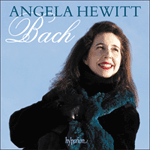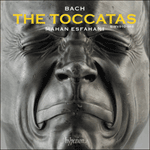‘Her performances could hardly be more stylish or impeccable, more vital or refined; and, as a crowning touch, Hyperion's sound is superb’ (Gramophone)
‘Angela Hewitt’s intelligent virtuosity, stylish command and uncluttered musicianship not only serve the composer well, but also prove how vibrant and expressive the toccatas can and should sound on the modern concert grand’ (BBC Music Magazine)
‘Imaginative and exciting performances’ (The Observer)
‘She proves once again that she is an exemplary exponent of Bach’s keyboard music on the piano, making these complex pieces flow with uninterrupted inspiration’ (The Independent)
‘A lovely tone, a seamless legato, some delicious dissonances – perfectly gauged and subtly nuanced – and some probing recitatives’ (American Record Guide)
‘In Hewitt’s hands [the toccatas] evince a molten quality that places the listener in close proximity to the act of composition’ (International Record Review)
‘Like the music itself, the performances brim with that improvisatory spontaneity that is the hallmark of this player’s style’ (The Sunday Times)
‘Faultless articulation and sensitive phrasing’ (Classic FM Magazine)
‘Interpretations that are first class from beginning to end’ (Fanfare, USA)
‘Hewitt brings a sublime grace and thoroughly musical fluidity to Bach’s endlessly creative writing … fabulously involving and beautifully performed’ (HMV Choice)
‘She succeeds remarkably in giving each work a differently slanted emotional colour, while every detail emerges with glittering definition … a fine disc’ (Pianist)
‘This album is now the benchmark recording of these works on the piano’ (Goldberg)
‘There is much brilliant playing here … the total impression is of interpretations that are superbly performed, clean, clear and serious’ (International Piano)
‘Exquisite playing … This disc reinforces Hewitt's position as one of the supreme Bach interpreters and provides the ideal entry point for newcomers to her’ (Music Week)
‘This disc is a delight from start to finish, a disc to lift the saddest of spirits’ (BBCi)
‘Interpretations of the highest quality … For sheer virtuosity she makes us hold our breath at the combination of clarity, dynamic variety and structural comprehension, which is faultlessly conveyed’ (Musical Opinion)
«La pianiste possède en effet une très belle sonorité, travaillée et personelle» (Classica, France)


 Bach: Angela Hewitt plays Bach
Bach: Angela Hewitt plays Bach Bach: The Toccatas
Bach: The Toccatas
